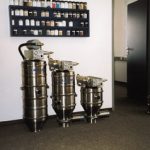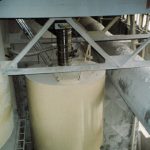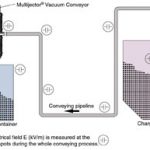The trend in the design of conveying systems is increasingly towards customised, tailor-made units. When account is taken of the various demands which have to be satisfied when reactors are loaded with solids, it becomes clear that a modular design of the individual components is the only way to achieve an economical, cost-effective vacuum conveyor.
Thomas Ramme
The multiple-stage Multijector vacuum pumps create the required air-flow rate for conveying at an optimum working pressure of 5.5 bar (flow pressure).
Suction volumes of up to 40,000 lN/min. and negative pressures of up to 910 mbar are reached during this process. With some applications, however, it is difficult to maintain an operating pressure of 5.5 bar during the pneumatic conveying process, especially when several consumers have to be fed.
Nozzle system lowers the operating pressure
An alternative nozzle system, which achieves the maximum energy gain at an operating pressure of just 3.5 bar, has been developed for this purpose.
In addition to the usual advantages such as freedom from wear and maintenance, a small size and a lightweight construction, the utilisation of compressed air, which is in any case efficient due to the multiple-stage nozzle system, is improved even further because less compression work is necessary at an operating pressure of 3.5 bar. Due to the modular design of the Multijector vacuum pumps, the number of available models doubles with the low-pressure nozzle system, thus facilitating an even more exact layout for the specific conveying task (Fig. 1).
A further advantage is the cyclic operation of the vacuum pumps, because bulk materials are often conveyed discontinuously. Whereas conventional suction-air generators have to operate continuously, even during non-working periods, owing to the long reaction time, with a Multijector the required vacuum is available directly after turning on.
Impeccable hygiene
Especially in the chemical-pharmaceutical industries, all parts of the vacuum conveyor in contact with the product have to be cleaned relatively easily and must therefore be straightforward to disassemble. This is en-sured by the modular design based on a flexible building-block principle. If, however, this design cannot be applied to large vacuum conveying systems and fixed installa-tions on account of the weight, a CIP solu-tion can be developed on request together with the customer.
One of the building blocks in this concept is the externally operated discharge valve of the vacuum conveyor (Fig. 2). The complete pneumatic system is installed outside the area in contact with the product. Moreover, a variety of special steels can be used as an alternative. The logical internal design without any gaps or clearances makes thorough rinsing possible. In addition, this discharge valve option can be dismantled and cleaned easily and without any tools in the usual way.
Compact size
As a rule, a vacuum conveyor is mounted directly above the unit which has to be loaded (Fig. 2). Since the remaining space between the existing plant components and the roof often proves to be very small, it is extremely important in such cases to keep the overall height of the conveying equipment to a minimum. Figure 1 shows the three height reduction stages made possible by the modular design.
On the left is a conventional vacuum conveyor. The height is reduced as a result of installing the externally operated discharge valve (centre), because the segment with the integrated funnel is no longer necessary. If a special flat filter is installed as well, the outcome is a very compact conveyor which is also ideal for mobile applications (right).
Fit for Ex areas
In pneumatic conveying systems, electro-static fields can lead to sparking and cause dust explosions with disastrous consequences. Firstly, it is possible for electrostatic fields to be produced by the components of the conveyor itself. Secondly, electrostatic charge caused by friction during the conveying process has to be taken into account particularly. Vacuum conveying inherently offers more safety than pressure conveying, because the oxygen fraction which is needed to form an explosive mixture is lower in the negative pressure region than with overpressure. Moreover, the oxygen fraction can be reduced further by specific injection of an inert gas into the separator tank during the discharge process. In addition to analysing the various physical and chemical characteristics of the powder to be conveyed, it is necessary to examine the individual components of the conveying system in more detail.
Multijector vacuum conveyors are exclusively driven by compressed air. The conveyor can also be controlled purely pneumatically. No electrostatic fields are therefore produced by electric motors or coils.
Conventional vacuum generators produce a considerable amount of radiant heat and thus increase the risk of ignition. Compressed air-driven vacuum pumps according to the Multijector principle work with expanding air jets on the other hand and therefore cool off slightly during operation.
Isolated, conductive parts in the conveying system represent particular danger sources for the classical spark discharge variant. These might be, for example, sealed inspection gates, doors of filter chambers, isolated conveyor pipe-lines or couplings. In this case, one important parameter for the electrostatic charge potential is the ventilation slot between two isolated parts in the system, as these parts work together like a capacitor. The larger the ventilation slot, the greater the accumulated energy.
If the charge reaches 2,000 kV/m, for example, a spark-over is possible depending on the accumulated energy.
The special design of the Multijector vacuum conveyors prevents such charge accumulations from occurring, because all parts in contact with the product are connected together electrically and charges are diverted by a common earthing connection. If suction hoses are used, electrically conductive and antistatic variants are possible, whereby the additional wire winding is earthed.
Another parameter for assessing the potential danger is the volume of the separator tank. Studies have shown that no explosions occur below a specific tank volume. Thanks to their extremely small size and cyclic conveying (suction – discharging) of comparatively small powder quantities, Multijector vacuum conveying systems have proved to be particularly safe.
This has been verified, for example, by vacuum conveying trials conducted jointly with a major chemical concern.
PE granules, which are ideal from the point of view of electrostatic charge, were used as the material to be conveyed. These PE granules were conveyed from a metal tank to a plastic barrel over a distance of 6 m. The electrostatic field E [kV/m] was measured throughout the whole conveying process: first at the suction lance, then along the conveyor pipeline, next at the vacuum conveyor itself and finally at the product discharge (Fig. 3).
All the measured values for the factor 100 were below the critical values stated in scientific literature. The conveying velocity is also important of course. The areas of dilute phase conveying (low product charge) at 20 to 35 m/s should be avoided with critical applications. The Multijector vacuum pumps offer particular advantages here because they are able to create a high final vacuum of 910 mbar. Plug-flow conveying (high product charge) can thus be achieved and the air velocity reduced to 5 to 12 m/s.
If parts made of electrostatically chargeable, but non-conductive, materials exist in the conveying system, particular account has to be taken of the possibility of a brush or a propagating brush discharging.
Volkmann
++49/2921/6 38 39
Further information cpp-203
Unsere Webinar-Empfehlung
Der Webcast MTP und modulare Produktion bietet eine einzigartige Gelegenheit, mehr über die aktuellen Entwicklungen bei MTP und in der modularen Produktion zu erfahren.
Chemie- und Pharmaproduktion braucht mehr Flexibilität
In der heutigen sich schnell wandelnden Welt stehen…
Teilen:













